ISO 188 Accelerated Aging Testing of Rubber
The ISO 188 standard is widely recognized for its rigorous approach to accelerated aging tests of rubber. This testing method simulates the effects of prolonged exposure to heat and light, which are significant factors in the degradation process of rubber materials used in various industrial applications.
During this test, specimens undergo controlled heating cycles combined with exposure to artificial light sources designed to mimic environmental conditions. The purpose is to rapidly induce changes that would normally take place over many years under actual service conditions. This allows manufacturers and quality control teams to evaluate the performance of rubber parts before they reach market.
The testing process starts by preparing specimens according to specific dimensions outlined in ISO 188, ensuring uniformity across all samples. Once prepared, these samples are exposed to an accelerated aging environment that includes temperature cycling between specified upper and lower limits, typically ranging from room temperature up to around 60°C. Additionally, exposure to UV light or xenon arc lamps simulates the effects of sunlight on rubber materials.
After undergoing this accelerated aging process, the specimens are inspected for changes in color, surface properties, tensile strength, elongation at break, hardness, and other relevant physical properties. Any degradation observed can provide valuable insights into the durability and longevity of these materials under real-world conditions.
The results from ISO 188 testing play a crucial role in ensuring that rubber components meet strict quality standards across multiple industries including automotive, aerospace, medical devices, packaging, and consumer goods. By providing accurate data on how different types of rubber will perform over time, this test helps engineers design more reliable products while also reducing costs associated with premature failures.
Our laboratory adheres strictly to ISO 188 guidelines when performing these tests, ensuring that every measurement is precise and consistent. Our experienced technicians use state-of-the-art equipment calibrated according to international standards to achieve reliable results. We provide detailed reports summarizing all findings along with recommendations for improvement where necessary.
In conclusion, ISO 188 accelerated aging testing of rubber offers an invaluable tool for assessing the quality and longevity of rubber materials used in various applications. By simulating environmental factors that cause degradation, this method enables manufacturers to make informed decisions about product design and material selection early on in their development process.
Why Choose This Test
- It provides an accurate assessment of how rubber materials will perform over extended periods.
- The accelerated nature of the test allows for quicker turnaround times compared to real-world aging processes.
- Results are consistent with international standards, ensuring reliability and comparability across different laboratories.
- This testing method is suitable for various types of rubber products used in diverse industries.
- Rapidly identifies potential weaknesses or vulnerabilities in new materials.
- Helps optimize formulations to extend the service life of rubber components.
- Saves time and resources by eliminating unnecessary iterations during product development.
International Acceptance and Recognition
The ISO 188 accelerated aging test has gained widespread acceptance in numerous countries worldwide due to its scientific rigor and reproducibility. Many regulatory bodies, including those responsible for automotive safety standards (e.g., SAE) and environmental regulations (e.g., European Union directives), reference or require compliance with this standard.
By adhering to ISO 188 guidelines, manufacturers can demonstrate their commitment to producing high-quality products that meet international quality benchmarks. This recognition also enhances market credibility, as customers increasingly demand evidence of rigorous testing before purchasing rubber components.
Use Cases and Application Examples
| Application Example | Description |
|---|---|
| Automotive Tire Manufacturers | Evaluating the durability of tire compounds exposed to harsh weather conditions. |
| Battery Manufacturers | Assessing the impact of temperature cycling on battery encapsulants. |
| Medical Device Makers | Determining the stability of rubber components in sterilization processes. |
| Packaging Industry | Testing sealant materials for packaging containers subjected to high temperatures and humidity levels. |
| Aerospace Component Suppliers | Evaluating the integrity of rubber seals used in aircraft engines exposed to extreme temperatures during flight. |
| Consumer Goods Manufacturers | Assessing the longevity of rubber grips on consumer electronics devices exposed to sunlight and heat. |
- Automotive: Ensuring tires maintain their grip under various weather conditions.
- Battery: Verifying seal integrity during charging cycles.
- Medical: Guaranteeing sterility of encapsulated components.
- Packaging: Confirming container durability and sealing effectiveness.
- Aerospace: Assessing engine component reliability in extreme environments.
- Consumer Goods: Evaluating product comfort and longevity.





